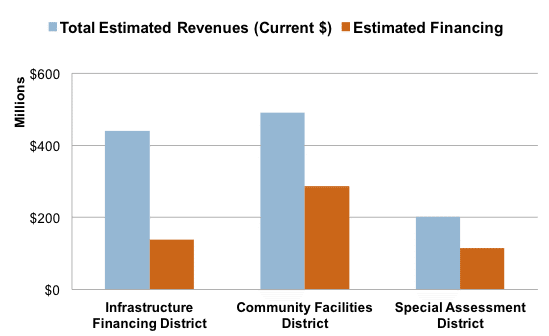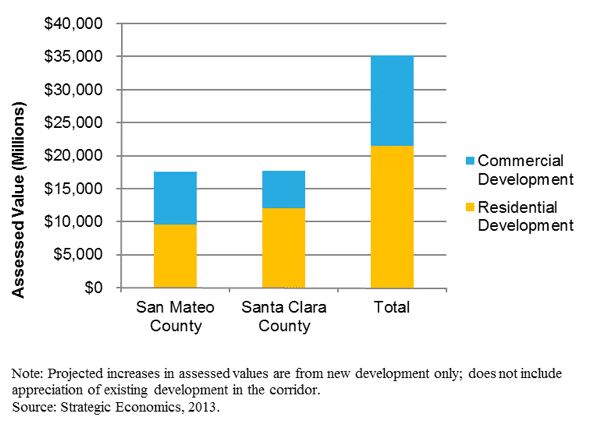PUBLIC FINANCE
Financing the many types of public improvements needed to support infill and transit-oriented development is a major challenge nationwide. Strategic Economics assists local governments, community groups, foundations, financial institutions and federal agencies in strategizing to overcome this challenge. We help clients identify and implement the innovative funding tools and financing strategies that are best suited to a given project’s particular infrastructure needs and market context. Potential funding and financing mechanisms we consider include assessment or special tax districts, impact fees, tax increment finance, transactional fees, parking fee revenues via parking management districts, and public/private partnerships. We assist clients in their use and development of funding tools and strategies for affordable housing and transit, and for the economic growth and small business support programs that are key to achieving smart growth and equity goals.
21 ELEMENTS AFFORDABLE HOUSING IMPACT FEE NEXUS AND FEASIBILITY STUDIES
Client: 21 Elements
Location: San Mateo County, CA
21 Elements is a partnership between all the local jurisdictions in San Mateo County focused on strategies to address the region’s affordable housing crisis, including identifying new funding tools. Strategic Economics was retained to conduct nexus studies for affordable housing impact fees, which would mitigate the impact of new development on the demand for affordable housing. The fee revenues collected can be used to provide funding for lower income housing.
The study considered affordable housing demand for targeted income groups in each jurisdiction, and calculated the maximum impact fees that would be legally defensible. Based on additional financial feasibility and policy analysis, the study recommended fee levels that can be feasibly implemented in each jurisdiction. The nexus and feasibility studies provide local decision-makers with the information and analysis required to implement the new impact fees.
As a result of the study, eight jurisdictions have begun to move forward with implementing new affordable housing impact fees, and/or with updating existing inclusionary housing policies. Strategic Economics is continuing to provide technical support to localities, including attending City Council and Planning Commission hearings to discuss the study’s methodology and policy issues.
CENTRAL SUBWAY VALUE CAPTURE STUDY
Client: San Francisco Planning Department and Municipal Transportation Agency
Location: San Francisco Bay Area
Strategic Economics assisted the San Francisco Planning Department and the Municipal Transportation Agency in understanding the potential for use of value capture funding mechanisms to assist with the cost of a proposed extension of the T-Third LRT line from Chinatown through North Beach and Russian Hill to Fisherman’s Wharf. Working closely with City staff, Strategic Economics identified the range of value capture mechanisms that might be utilized. For selected mechanisms, Strategic Economics estimated the amount of funding that might be generated if deployed in conjunction with changes to height limits in selected parts of Fisherman’s Wharf. The analysis includes estimating property value impacts on existing properties and new development, as well as evaluating the amount that might be “captured” using an infrastructure financing district, special assessment district, community facilities district, or a development fee.

VALUE CAPTURE STRATEGIES FOR TRANSPORTATION INFRASTRUCTURE PROJECTS
Client: Metropolitan Transportation Commission
Location: San Francisco Bay Area
The Metropolitan Transportation Commission (MTC) hired Strategic Economics to lead an effort intended to expand the use of value capture to pay for projects included in the Regional Transportation Plan. The term “value capture” generally refers to property-based funding strategies under which a public agency “captures” a portion of an increase in property values generated by a public infrastructure project to help pay for the infrastructure itself. For this effort Strategic Economics prepared a toolkit of value capture strategies and led a series of workshops to educate MTC and other public agency staff about the potential to use value capture to pay for transportation infrastructure projects in the San Francisco Bay Area. Strategies described in the toolkit include special assessments and taxes, tax increment financing mechanisms, developer contributions and other public sector real estate strategies. The interactive workshops provided an overview of value capture strategies and case studies of real world examples of projects using such strategies to pay for transportation projects.
OPPORTUNITIES FOR IMPLEMENTING TRANSIT BENEFIT ASSESSMENT DISTRICTS IN THE BART SYSTEM
Client: San Francisco Bay Area Rail Transit District
Location: San Francisco Bay Area, CA
In October 2013, the State of California enacted Senate Bill (SB) 142. The legislation provides transit agencies with the authority to create benefit assessment districts (known as transit benefit assessment districts, or TBADs) within a half-mile of a transit station in order to finance the construction and maintenance of eligible transit projects. Strategic Economics worked with BART to clarify the possible uses and likely limitations of the new legislation, and identify a list of BART station areas in Alameda and Contra Costa Counties that present near-term opportunities for pioneering the use of this new financing tool.
Strategic Economics assisted in clarifying the potential applications of the TBAD tool given limitations imposed by the California constitution, state statute, and recent court cases. Based on this information, Strategic Economics then worked closely with BART staff to identify planned BART improvements that could qualify for TBAD funding – specifically, projects that would provide a direct, special benefit to the property owners who would be subject to the assessment. Finally, Strategic Economics created a short list of seven station areas where an assessment district is most likely to be feasible. BART is currently moving forward with its efforts to be the first transit agency in the state to create a TBAD.
GRAND BOULEVARD INITIATIVE INFRASTRUCTURE NEEDS ASSESSMENT AND FINANCING STRATEGY
Client:Santa Clara Valley Transportation Authority
Location:Santa Clara County, CA
The Grand Boulevard Initiative (GBI) is a regional collaboration of 19 cities, two counties, and other local and regional agencies dedicated to improving the performance, safety, and aesthetics of the 47-mile El Camino Real corridor, stretching from Daly City to San Jose.
In 2011, Strategic Economics worked as part of a consultant team to assess the capacity of a wide range of infrastructure needs along the El Camino Real corridor, and to identify funding and financing strategies to address those needs. In addition to traditional funding sources, Strategic Economics evaluated a variety of emerging and innovative tools, including pooled regional grant funds, value capture mechanisms that could serve as an alternative to redevelopment tax increment financing, congestion pricing, proceeds from California’s cap-and-trade auctions, private infrastructure investment funds, and solar power and other technologies that generate renewable energy from roadways.

EPA SMART GROWTH TECHNICAL ASSISTANCE – INFRASTRUCTURE FINANCING OPTIONS FOR TOD
Client: Environmental Protection Agency (EPA)
Location: National
The Environmental Protection Agency’s (EPA) Smart Growth Implementation Assistance (SGIA) program, a technical assistance program for state, local, regional, and tribal governments that want to incorporate smart growth techniques into their future development, engaged a consultant team consisting of CH2MHill, Strategic Economics, and ARUP to evaluate new and innovative strategies for financing transit-oriented development (TOD) infrastructure. Strategic Economics, acting as the technical lead for the effort, worked with the rest of the consultant team and the EPA to prepare the report, “Infrastructure Financing Options for Transit-Oriented Development,” a comprehensive guidebook to the tools and strategies for funding and financing the infrastructure needed to support TOD.
As part of this effort Strategic Economics and the consultant team also provided targeted technical support to local communities receiving grants from the EPA’s SGIA program. The four grantee communities (Cobb County and the Cumberland Community Improvement District, Georgia; South Suburban Mayors and Managers Association (Chicago area), Illinois; Utah Transit Authority, Salt Lake City, and Sandy City, Utah; and City of Wheat Ridge, Colorado) received assistance in evaluating potential mechanisms for financing TOD infrastructure.
The Infrastructure Financing Options for TOD guidebook includes an inventory of existing and emerging tools for funding and financing TOD infrastructure, demonstrates how a selection of funding and financing tools can be assembled into financing models that communities can use to finance infrastructure; and applies the lessons learned to the four EPA SGIA grant recipient communities. The inventory of funding and financing tools provides background information about how the tools work, including applicability to different types of infrastructure, approval requirements, legal and political considerations, the capacity of the tool and the scale of infrastructure, whether the tool relies on public or private funds or a mix of these, and the risk profile of the tool.
